Why Upper Bust, Rather than Bust?
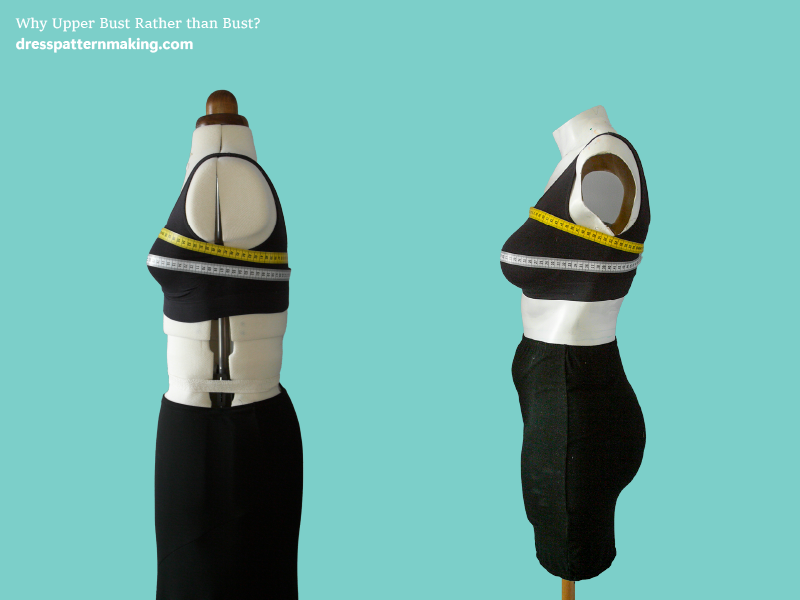
In my instructions, I use the Upper Bust measurement for the width of the Bodice Block, not the Bust measurement. Most block making instructions use the Bust measurement, so why am using the Upper Bust?
The short answer
Instructions that use the Bust Measurement will end up with a Bodice Block that has an Upper Bust measurement 2 inches smaller than the Bust Measurement. This is fine if you are a B-bust cup, but all other bust cups will end up with the wrong amount of ease in the underarm (Upper Bust) area. Starting with the Upper Bust measurement means that all bust cup sizes will end up with the correct amount of ease in the Underarm/Upper Bust. They will also end up with the correct amount of ease in the bust. Using my instructions you can also create the correct dart size for your bust cup. If you have a Bust-Cup larger than a B-cup, this means you will not have to go to the trouble of (a) adjusting the extra width in the upper bust, and (b) doing a large bust adjustment. With my instructions, both of these are done in the block creation process.
The Long Answer and the Validation
The rest of this article is for anyone who wants the details of how this works, and for those who doubt it.
Note: Bust Cup Sizes
Bust Cups as they relate to blocks and patternmaking may not be the same as what you are used to as far as Bra Cup Sizes go. Either read below to get those details, or go to the page Bust-Cup-Sizes.
Basing the Bodice Block on Bust measurement plus ease
Most Bodice Block instructions use the bust width, plus the amount of ease required at the bust level, as the width of the block. They also create dart width/s suitable for a figure with a B-cup. A block made with this method will fit you in the bust and underarm area if you are a B-bust-cup, but not so well if not. (Yes, you can make modifications afterwards, but wouldn't it better if you could incorporate it into the block making process?). If you have a smaller or larger bust cup and you want a well-fitting block, using the Bust measurement method you will need to make alterations in two areas after you have completed the block; the ease in the underarm and the size of the dart/s. (And as a beginner, you may not understand this and be caught out by the Large Bust Adjustment Gotcha). However, if we base the block on the Upper Bust (rather than the Bust) + the amount of ease needed at the Upper Bust level, not to be confused with the amount of ease we need at the bust level, we eliminate the underarm-ease problem, and then we can also take into account the bust measurement and create the correct dart-size using this method. Yes, we will end up with sufficient ease at the bust level.
No difference for Women with a standard B-Bust-Cup
For women with B-bust-cups, there is no added benefit of using this method rather than the usual method; they will end up with the same result regardless. BUT there is an important question here: Are you defining yourself as a B-bust-cup according to Bra Size? You may not actually be a B-bust-cup for block and patternmaking purposes, and could therefore end up with a less-than-well-fitting-block. (e.g. Although the bras I buy are DD or larger, for the purposes of my block I am a D cup). To reiterate: For a B-bust cup, using the Upper Bust Measurement + Upper Bust Ease method will achieve the same result as using the Bust Measurement + Bust Ease. I will be showing this in detailed examples below. The rest of this articles shows how this method works, comparing it with other methods/instructions.
What is the Upper Bust (or High Bust)?
This is the measurement around your chest and under your arms - around your underarm level if you're wearing a fitted shirt with sleeves. The first image on this page shows where the Upper Bust (yellow tape measure) and Bust (white tape measure) are on a mannequin with an A-bust-cup and a Body-Cast with a D-bust-cup.
How are Bust Cup Sizes Defined?
For the purposes of block and patternmaking, bust cup sizes are based on the difference between the measurement of your Upper Bust (or High Bust) and your (Full) Bust. If you subtract your high bust from your full bust, the difference determines your cup size:
- 1″ = A cup
- 2″ = B cup
- 3″ = C cup
- 4″ = D cup
- 5″ = DD cup (or E cup)
- 6″ = DDD cup (or F cup)
Regarding the Example Methods/Instructions/Authors that I refer to
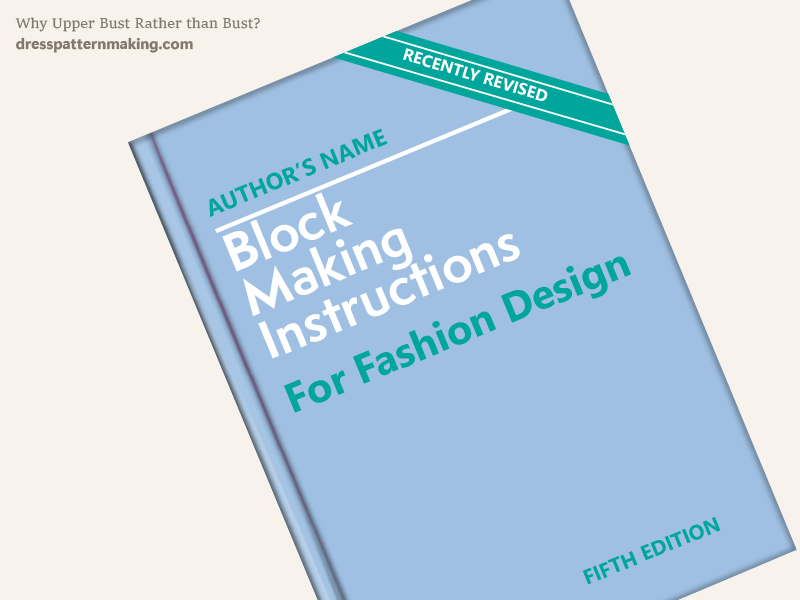
There are a number of block making methods and quite a few authors who have written instructions for creating blocks. I have looked at and used seven different instructions. My conclusions about the amount of ease, etc., comes from these different methods. As it would be too time-consuming to dissect each and every one of them, I have chosen two to dissect and refer to. They are:
- Winifred Aldrich: Metric Pattern Cutting (Third Edition)
- Helen Joseph-Armstrong: Patternmaking for Fashion Design (Fourth Edition)
These instructions use two distinctly different methods: what I think are (and I may be wrong in naming them this way) - The American method and the English/European method. They result in slightly different amounts of ease in the bust and the armhole. (They also result in different looking blocks and have different assumptions. You can find a number of articles discussing these in the Other Menu). See my article: Analyzing Other Block Making Instructions for a list of the other block making instructions I have used, but am not using for the purposes of this example. (They are all pretty much the same regarding the amount of ease that I am covering here). The images that I use these following examples have been creating using instructions and the measurements in the above two books. All the images have been created full-scale and reduced in size and resolution for the web. They are - to stress the point - to scale. As I use Illustrator to create these, the measurements are accurate; they are created on an inch-gird or a cm-grid, they are not approximations.
Working Examples
In the following two examples I am creating two different bodice blocks: one using the instructions and measurements from the book by Winifred Aldrich. The other using instructions and measurements in the book by Helen Joseph-Armstrong. What I want to show in these examples is how much ease there ends up being in the Upper Bust and the Bust using these instructions.
Example #1: Aldrich
In the first image below, I've created a block following Aldrich's instructions, using the Size 10 measurements from her book. I'm using centimeters to create the block, because Aldrich uses the metric system, then converting the values to inches. The resulting inches are rounded approximations to make it simpler. (The second example is in inches, as Joseph-Armstrong uses the Imperial system). The bust for Size 10 is 84 cm.
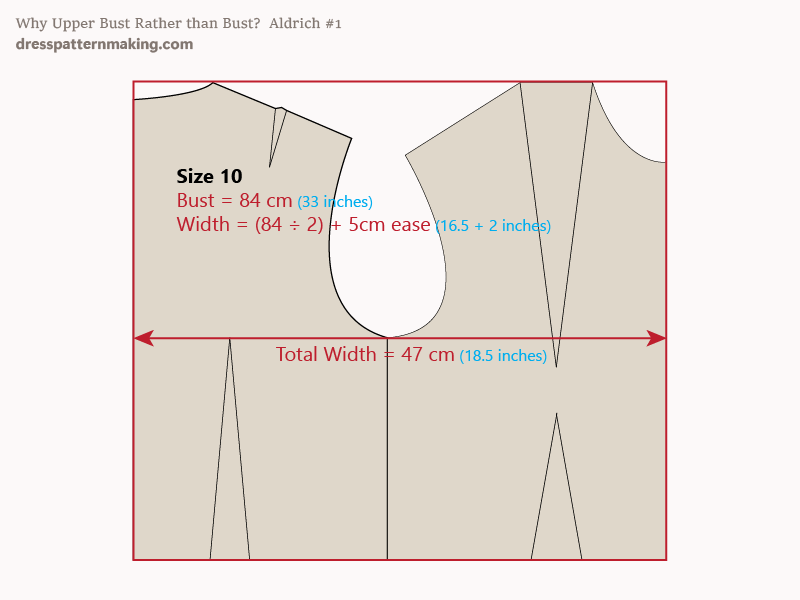
What I want to bring to your attention is the width of the block at the Upper Bust /underarm. As you can see on the image above, the total width of the block, which is based on the Bust Arc + Bust Ease, is the width of the block at the armhole. (Less the dart width at that level - see the next image) The bust is a few cms down from the armhole level; the shaping of the waist still needs to be done, and that will reduce the width at the bust level, as will closing the back waist dart. To make it easier to take the final measurements at the underarm and the bust, I have pivoted the shoulder dart to the waist, and now it is easier to take the final Upper Bust & Bust measurements, and determine how much ease there is. See the image below.
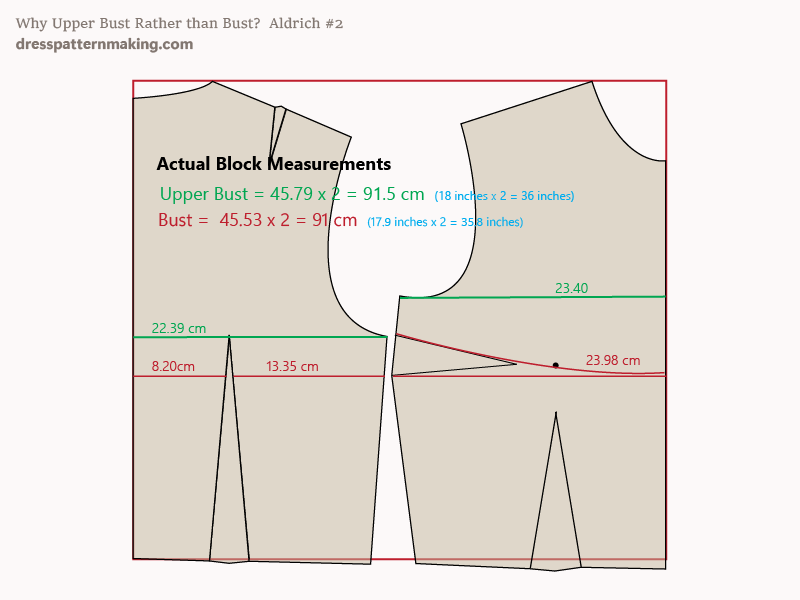
Bust Ease
If you do the calculations, the total measurement on the block at the bust level is 91cm. Given that the bust is 84cm, there is 7cm (or 2.75 inches) ease in the bust.
Upper Bust Ease
The total measurement on the block at the Upper Bust level is 91.5cm. Now remembering that the definition of a B-bust-cup is that there is two inches difference between the Upper-Bust and the Bust, this means that the actual body measurement at the Upper Bust is:
- 84 cm - 5 cm = 79cm
- 33 in - 2 in = 31 inches
So the Total Upper Bust measurements on the block, less the Actual Upper Bust measurement of the body will give us the amount of ease in the Upper Bust:
- 91.5 cm- 79 cm = 12.5cm
- 36 in - 31 in = 5 inches
(Two notes: The reason there is more ease at the Upper Bust level than at the Bust Level is that more ease in needed at the underarm level for the arm to move freely. A Sleeveless Bodice Block will have less ease in the underarm level than this Sleeve Block, but the Sleeveless Block will still have more ease at the underarm level than at the bust level).
The Problem
Now, as I've said before, this block is assuming that your Upper Bust is 2 inches less than your bust. If you have a Bust measurement of 84cm but you have a D bust cup, your actual Upper Bust measurement is 74cm, not 79cm. So instead of having 12.5cm (5 inches) ease, you will have 17.5cm (7 inches) ease. The larger your bust cup, i.e. the greater the difference between your Bust and Upper Bust, the bigger the problem will be. We will go through the same process with a different set of instructions before I go on to show how using the Upper Bust measurement prevents this problem.
Example #2: Joseph-Armstrong
In this example I've created a Bodice block following Joseph-Armstrong instructions, using her Size 10 measurements. This size 10 has a 36 inch bust the Back Arc is 8.63 and the Bust Arc is 10. I'm using inches to create the block because Joseph-Armstrong uses the Imperial system. I am not converting it to cm in this case.
Upper Bust Ease
The first image shows the width of the block at the Upper Bust:
- the Width of the Bodice Back is: Back Arc (8.63) + .75 inch ease = 9.38 inch
- the width of the Bodice Front is: Bust Arc (10) + .25 inch ease = 10.25 inches
- total of Back + Front x 2 = 39.26 inches
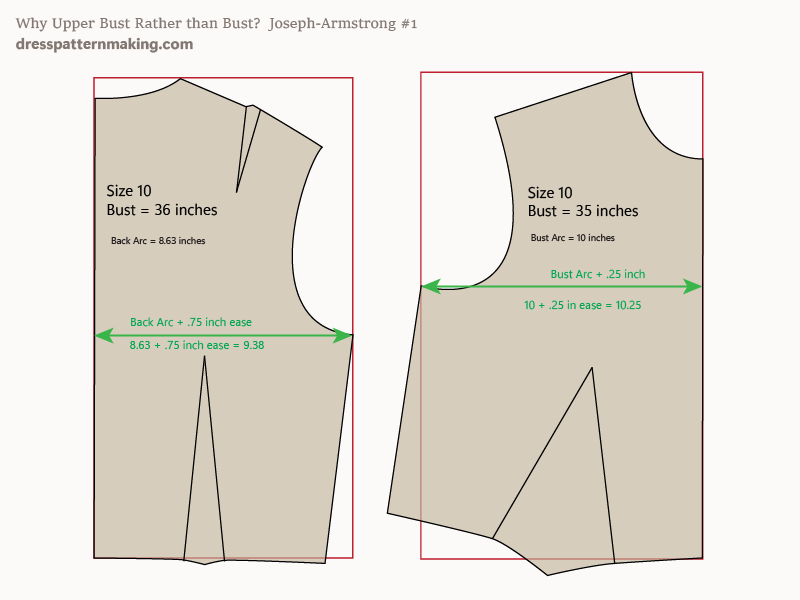
Since the Upper Bust is (assumed) to be 2 inches less than the bust, the Upper Bust Measurement is 34 inches, then there is therefore 5.25 inches ease in the Upper Bust.
Bust Ease
Let's confirm the amount of ease in the bust by measuring at the bust level on the block:

Adding the three measurement together, then multiplying them by two - (3.95 + 5.15 + 10.53) x 2 = 39.26. Which means there is 3.25 inches in the Bust.
Summary Ease in Joseph-Armstrong
- 5.25 inches ease in Upper Bust (compared to 5 inches Aldrich)
- 3.25 inches ease in the Bust (compared to 2.75 inches Aldrich)
Summary of Ideal Ease in Upper Bust & Bust
So let's look at what we learned from looking at the amount of ease in the Aldrich & Joseph-Armstrong examples above. Both of them resulted in a similar amount of ease in the Upper Bust and Bust.
- Upper Bust: 5.25 inches (Joseph-Armstrong), 5 inches (Aldrich)
- Bust: 3.25 inches (Joseph-Armstrong), 2.75 inches (Aldrich)
Let me throw something else in the mix. I looked at the Vogue and Simplicity Fitting Shells, and the ease for those were a little more: 6 inches in the Upper Bust, and 4 inches in the bust. (Actually 4 inches for a B-cup, less for a C-cup and less for D-cup...), The bottom line is that there is a Range of Ease that is acceptable for a Close Fitting Bodice Block. Most instructions for creating a bodice block would end up with something in this range. (Keeping in mind that with these block making instructions, this amount of ideal ease in the Upper Bust will actually only work for B-bust cups).
Range of Ease
- Upper Bust: 5 inches to 6 inches
- Bust: 2.75 inches to 4 inches
Creating the Block using the Upper Bust
But if I made it for my Upper Bust, there wouldn't be enough ease in the Bust! My instructions use the Upper Bust measurement as the starting width of the block. You may think we're not going to end up with sufficient ease in the bust. Well... that's not the case. We will go through two examples to show how it will work. Keep in mind though that we will be using: Upper Bust measurement + Upper Bust ease compared to Bust measurement + Bust ease. Another thing to keep in mind is that as the basic Bodice Block is a Close Fitting Bodice block, you want the minimal amount of wearing ease. Extra ease can be added when making patterns.
Example #1: B-Cup
Let's just see how using the Upper Bust measurement is going to work out simply for a B-cup using my Upper Bust measurement + Upper Bust ease method: Bust measurement: 36 inches Upper Bust measurement: 34 inches
- Using the Upper Bust measurement to create the block, the width at the Upper Bust will be 34 inches + 5.25 ease = 39.25 inches.
- Given that the bust is 36, at the bust level the ease is: 39.25 - 36 = 3.25 inches
- We have the ideal amount of ease in Upper Bust (5.25 inches)
- We have the ideal amount of ease in the Bust (3.25 inches)
So for a B-cup... same result... Using Upper Bust + Upper Bust Ease EQUALS Bust + Bust Ease
Example #2: D-Cup
In this example, the bust measurement is the same, but it's a D-cup, so the Upper Bust measurement is different. Let's repeat what we did above. Bust measurement: 36 inches Upper Bust measurement: 32 inches
- Using the Upper Bust measurement to create the block, the width at the Upper Bust will be 32 inches + 5.25 ease = 37.25.
- The bust is 36 inches, so... Oh, no! We have only 1.25 inches ease
Not quite.... You are not taking into account that the width of the block is at the underarm level; the bust is further below.... We will actually get another 1 inch ease by:
- the creation of the D-cup dart
- the fact that the bigger the bust cup, the lower the bust is....
See the image below:
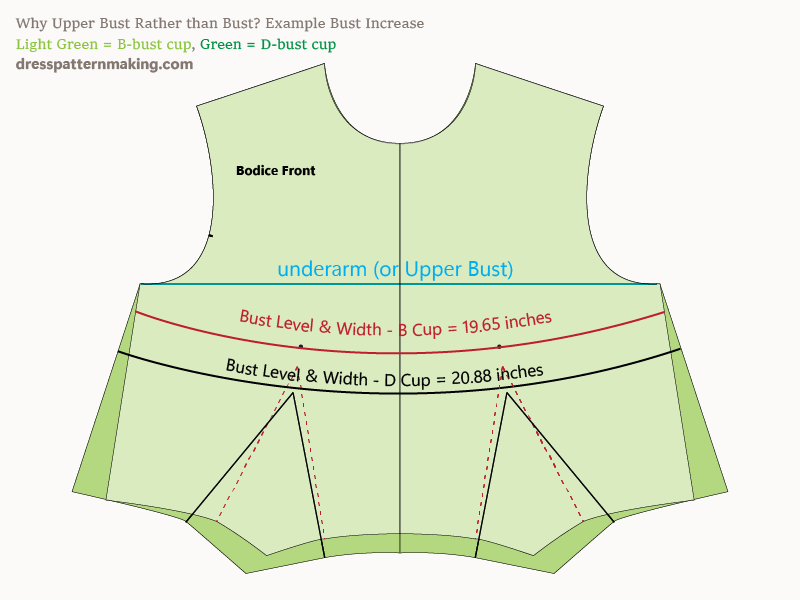
So let's redo that calculation:
We have an additional 1 inch ease after creating the correct bust cup, so let's add that in:
- Upper Bust = 37.75 inches
- Bust measurement = 36 inches
- = 1.25 inches ease + 1 inch we will gain from the dart increase
- We have 2.25 inches ease in the bust. (The length of the Back Waist Dart can impact this - see note near bottom of page)
Given that we are working with the ideal ease of 3.25 inches, we are missing 1 inch ease. OK.... so instead of adding 5.25 inches ease in the Upper Bust, let's try adding 6 inches instead (remember there's a range, and 6 inches is still much better than the 7.25 inches you'd end up creating it the other way!)
- Upper Bust = 32 inches, plus 6 inches ease = 38 inches
- 38 inches - 36 inches bust = 2 inches ease in bust
- Plus the 1 inches we have gained with the bust dart increase
- Total ease in bust = 3 inches....
So we have 3 inches ease in the bust; this is slightly less than the 3.25 we were aiming for, but remember that Aldrich's block ended up with 2.75 inches, so it's still sufficient. And we have only 6 inches in the Upper Bust, rather than 7.25 inches. It works for each bust cup; we just need to change the amount of Upper Bust Ease for each one.
Summary of Examples using Upper Bust Method
- For a B-cup, if you use the base width of your block as your Upper Bust + 5.25 inches ease. you will end up with the bust having 3.25 inches ease. You end up with the same result as the other block making methods.
- For a D-cup, if you use the base width of your block as your Upper Bust and add 6 inches ease, you will end up having 3 inches ease in the bust. And you will only have 6 inches ease in the Upper Bust rather than 7.25.
Therefore.....
If you use your Upper Bust measurement + Upper Bust ease for the width of the block, and use the following amount of Upper Bust Ease - you will end up with (1) a reasonable amount of ease in the Upper Bust and (b) sufficient ease in the bust:
- A-Bust-Cup: 3.87 inches ease
- B-Bust Cup: 4.25 inches ease
- C-Bust-Cup: 4.63 inches ease
- D-Bust-Cup: 5 inches ease
- DD-Bust-Cup: 5.38 inches ease
The amount of ease in both the Upper Bust and Bust is the same for the B-cup using this method and the traditional method. For the other bust-cups, the amount of ease in the Upper bust and bust are closer to the ideal (what the B-cup has) than using the Bust measurement + Bust-ease. If we wanted to make it easier - for example if we were making the same basic block for all bust-cup sizes and just changing the bust-cup size (which is what commercial patterns would have to do) , then we could add 6"" to all of them. The A and B cup would have a bit more than necessary, and the larger sizes would have enough.
Additional Notes regarding Image: Example Bust Increase (up the page)
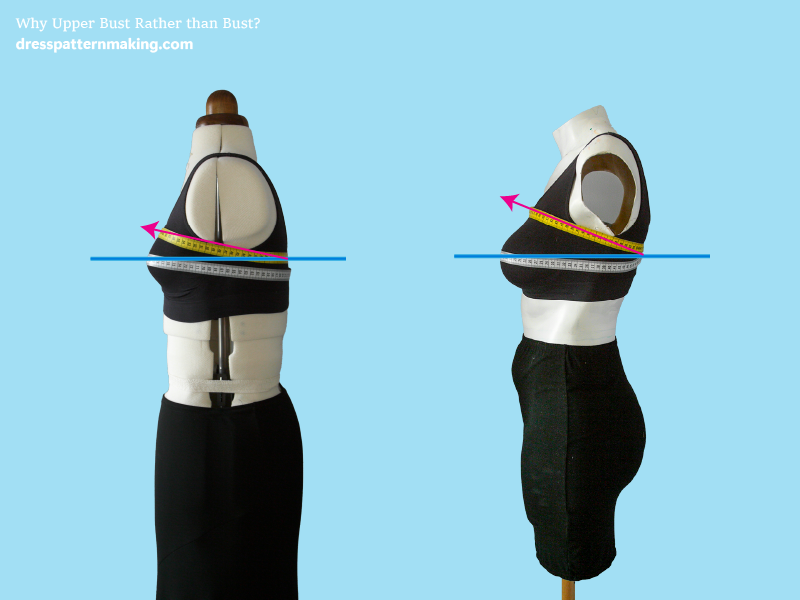
Note A: Larger busts are lower
In the image up the page that compared the measurement of the bust line of the B-cup and the D-cup, the D-cup line was drawn further down the block from the B-cup. This is the nature of a larger bust - due to gravity, it sits lower. To the left is the same image of the mannequin and my body cast that appears at the top of the page, with pink lines drawn at the bust level. You can see that the D cup bust line is further down from the armhole than the B cup line.
Note B: Reduce Height of Back Waist Dart
Refer to the image below: If the bust line has dropped down on the Bodice Front, it has similarly moved down on the Bodice Back. The black waist dart lines are the B-cup dart lines. The D-cup darts in the Bodice Back should be correspondingly shorter. Otherwise you will lose some bust ease that you gained on the front.
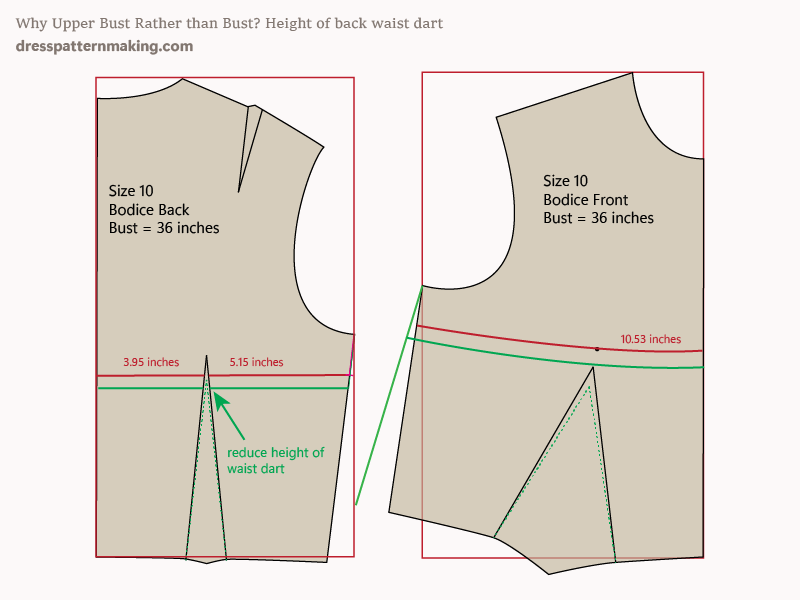
What if my Upper Bust measurement is the same as my Bust measurement, but I wear a B-Cup Bra.
When I first came up with my method of drafting the Bodice Block based on the Upper Bust, I was focused on my type of figure; that is, a small Upper Bust and Large Bust. I was contacted by a few women who had the same or similar measurements for the Upper Bust and Bust, but who had a significant size bust. This made my look at my system again and revise it to make sure the system worked for all figure types. I revised my system to use the Bust Arc measurements (Upper Bust Arc Front, Upper Bust Arc Back, Bust Arc Front and Bust Arc Back) rather than just using the Upper Bust measurement divided by 2 and the Bust measurements divided by 2. If you want a complete understanding of my system and see how it works with step-by-step instructions and examples, watch the videos in the Bodice Block Essentials playlist on my YouTube channel. So the answer the question is: The instructions in the Bodice Block videos dated March 2022 (Bodice Block Front and Bodice Block Back in both Imperial and Metric measurements) will work.The written instructions on the website under the Blocks Menu are my original instructions that don't use the Arcs and they will not work for you. If you want written instructions of my latest instructions that include the Arc, you will need to purchase the PDF downloadable booklet found under the Shop Page.

